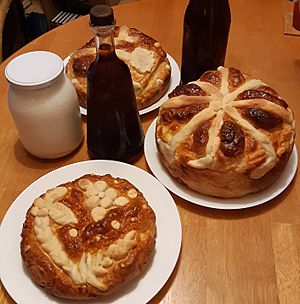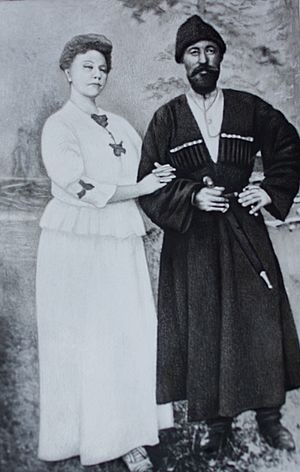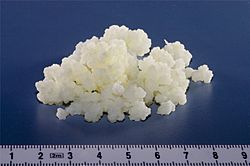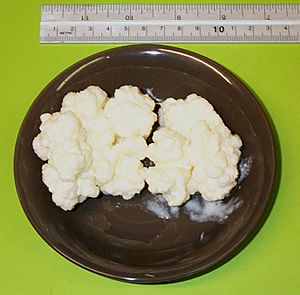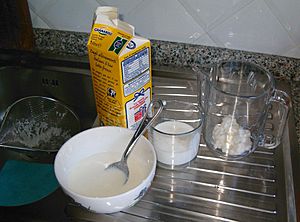Kefir facts for kids
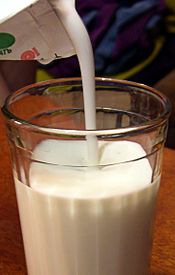
Plain milk kefir being poured
|
|
| Alternative names | Milk kefir, gıpı ayran, qundəps, búlgaros |
|---|---|
| Region or state | Russia, Caucasus, Eastern Europe, Scandinavia, Mongolia |
| Main ingredients | Milk and kefir grains |
Kefir (/kəˈfɪər/ KƏ-feer) is a special fermented milk drink. It's a bit like a thin yogurt or ayran. Kefir is made using "kefir grains," which are not really grains but tiny living communities of bacteria and yeast. This drink first came from the North Caucasus mountains, near Mount Elbrus. From there, it traveled to Russia, then spread across Europe and the United States. People make kefir by adding these special grains to milk from cows, goats, or sheep.
Kefir is a popular drink for breakfast, lunch, or dinner in many countries. These include Belarus, Estonia, Hungary, Latvia, Lithuania, Poland, Romania, Russia, and Ukraine. It's known there as a healthy and affordable drink. You can also find kefir in Norway, Sweden, and Finland. In countries like Bulgaria and Serbia, people drink kefir all day. They often enjoy it with savory pastries like burek or in cold summer soups.
Contents
The Story of Kefir: Where It Began
The word kefir has been used in Russian and Eastern European countries since at least 1884. It comes from old Turkic words that mean "milk froth" or "foam." Long ago, people in the Karachay-Balkar region made traditional kefir in goatskin bags. They would hang these bags near a doorway. Anyone walking by would gently knock the bags. This helped mix the milk and kefir grains well.
Kefir spread from the former Soviet Union to other parts of the world. By the early 2000s, it was known in Europe, Japan, and the United States. In some parts of Latin America, people call it búlgaros, which means "Bulgarians." The mountains near Elbrus are thought to be the true home of kefir. The Karachays and Balkars are credited with inventing the way to make it. A Russian food worker named Irina Timofeevna Sakharova was the first to bring kefir grains to Moscow. She learned the secret from a rich Karachay man named Bekmyrza Baychorov.
How Kefir Is Made: The Fermentation Process
Traditional kefir is made by letting it ferment overnight at room temperature. Fermentation is a process where tiny living things (like bacteria and yeast) change food. In kefir, they break down the sugar in milk. This makes a slightly sour, fizzy drink. It tastes and feels a lot like drinkable yogurt.
The kefir grains that start this process are like small cauliflower pieces. They can be white or creamy yellow. These grains are a complex community of many different bacteria and yeasts. They live together and help each other. One important part of the grains is a special goo called kefiran. It's made of sugars and helps the grains stick together. The types of microbes in kefir can change. This depends on things like the temperature or if the grains float in the milk. Today, many people use freeze-dried starter cultures. These are easier to transport and give a more consistent result.
During fermentation, the bacteria in the kefir grains break down lactose. Lactose is the natural sugar in milk. They turn most of it into lactic acid. This makes the kefir taste sour. Other things are also made, which give kefir its unique flavor.
Less Lactose in Kefir
Because bacteria and yeast break down lactose, kefir has less lactose than regular milk. Studies show that kefir can reduce lactose levels by 20-30%. This is good news for people who have lactose intolerance. They often find it easier to digest kefir and yogurt than regular milk. This is because the helpful microbes in kefir do some of the work for your body.
Alcohol in Kefir
Kefir contains a very small amount of ethanol, which is a type of alcohol. The amount is usually extremely low, often less than 0.05%. This is similar to the tiny amounts of alcohol found naturally in some fruit juices or ripe bananas. Older ways of making kefir might have had slightly more alcohol (1-2%). But modern methods use shorter fermentation times. This results in much lower alcohol levels, usually around 0.2–0.3%. So, the amount of alcohol in commercial kefir is generally not a concern.
What's Inside Kefir: Nutrition Facts
Kefir is packed with good stuff! It contains many important nutrients. These include different dietary minerals, vitamins, and essential amino acids. The amounts are similar to what you'd find in regular milk. Kefir is mostly water, but it also has by-products from fermentation, like carbon dioxide (which makes it fizzy) and that tiny bit of ethanol.
Nutrients in Kefir
Just like milk, kefir has several important minerals. These include calcium, phosphorus, magnesium, and potassium. It also contains small amounts of iron, copper, and zinc. Kefir also provides many vitamins. You can find vitamin A, several B vitamins (like B1, B2, B3, B6, B9, and B12), vitamin C, vitamin D, and vitamin E. Plus, it has all the essential amino acids that your body needs, just like any milk product.
Good Bacteria in Kefir
Kefir is famous for its probiotic bacteria. These are "good" bacteria that can help your gut stay healthy. Some common types found in kefir include Lactobacillus acidophilus and Bifidobacterium bifidum. These bacteria can be found in very high numbers in kefir. They are also responsible for making the special kefiran goo in the grains.
Besides bacteria, kefir often has different kinds of yeast. Some yeasts can use the lactose in milk, while others don't. The exact role of these yeasts in your body is still being studied.
Making Kefir at Home
To make kefir, you add kefir grains to milk. A good amount is usually 2-5% grains compared to the milk. Put the mixture in a glass jar or another container that won't rust. It's best to keep it in a dark place. This protects vitamins that can be damaged by light. Let it ferment for 12 to 24 hours at a mild temperature, ideally around 20–25 °C (68–77 °F).
After fermentation, you strain the grains out of the milk. Use a plastic or stainless steel strainer. The grains can then be used to make a new batch of kefir! During fermentation, the grains grow bigger and can even split, making more grains.
The fermented liquid is ready to drink. You can also use it in recipes or store it in a sealed container for a bit longer. Because kefir is acidic, don't store it in metal containers made of aluminum, copper, or zinc. These metals can mix into the kefir over time. Unrefrigerated, kefir can last up to thirty days.
Some places, like Russia, use a two-step method for making kefir on a larger scale. First, they make a "mother culture" with the grains. Then, they add a small amount of this mother culture to a larger batch of milk. You can also make kefir using freeze-dried cultures that come in powder form. These are often found in health food stores. While you can use some of this kefir to start new batches, it won't form new grains like the original kefir grains do.
Different Kinds of Milk for Kefir
Kefir grains can ferment milk from most mammals. They will also keep growing in these different milks. People commonly use cow, goat, and sheep milk. Each type of milk gives the kefir a slightly different flavor, smell, and texture. Traditionally, people often used raw milk.
Kefir grains don't just need milk sugar to grow. They can also grow in other liquids, like rice hydrolysate. You can even ferment soy milk with kefir grains. However, the grains might look and feel different because soy milk has different proteins. There's also a type of kefir grain that grows in sugary water. This is called water kefir. It looks and has different microbes than milk kefir.
Cooking with Kefir
[[File:Chlodnik_(Cold_Borscht).jpg|thumb|right|Lithuanian kefir-based borscht (šaltibarščiai)] Because kefir contains Lactobacillus bacteria, it can be used to make sourdough bread. It's also a great substitute for buttermilk in baking. Kefir is a main ingredient in cold borscht soup in Lithuania, sometimes called Lithuanian cold soup. Another popular kefir-based soup is okroshka, common in countries that were part of the former Soviet Union. You can use kefir instead of milk on cereal, granola, in milkshakes, salad dressing, ice cream, smoothies, and soup.
See also
 In Spanish: Kéfir para niños
In Spanish: Kéfir para niños


